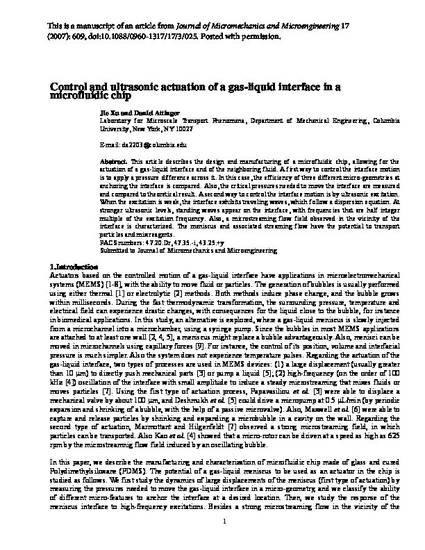
Article
Control and ultrasonic actuation of a gas–liquid interface in a microfluidic chip
Journal of Micromechanics and Microengineering
(2007)
Abstract
This paper describes the design and manufacturing of a microfluidic chip, allowing for the actuation of a gas–liquid interface and of the neighboring fluid. The first way to control the interface motion is to apply a pressure difference across it. In this case, the efficiency of three different micro-geometries at anchoring the interface is compared. Also, the critical pressures needed to move the interface are measured and compared to a theoretical result. The second way to control the interface motion is by ultrasonic excitation. When the excitation is weak, the interface exhibits traveling waves, which follow a dispersion equation. At stronger ultrasonic levels, standing waves appear on the interface, with frequencies that are half the integer multiple of the excitation frequency. An associated microstreaming flow field observed in the vicinity of the interface is characterized. The meniscus and associated streaming flow have the potential to transport particles and mix reagents.
Disciplines
Publication Date
March, 2007
Publisher Statement
This is a manuscript of an article from Journal of Micromechanics and Microengineering 17 (2007): 609, doi:10.1088/0960-1317/17/3/025. Posted with permission.
Citation Information
Jie Xu and Daniel Attinger. "Control and ultrasonic actuation of a gas–liquid interface in a microfluidic chip" Journal of Micromechanics and Microengineering Vol. 17 Iss. 3 (2007) Available at: http://works.bepress.com/daniel_attinger/14/
